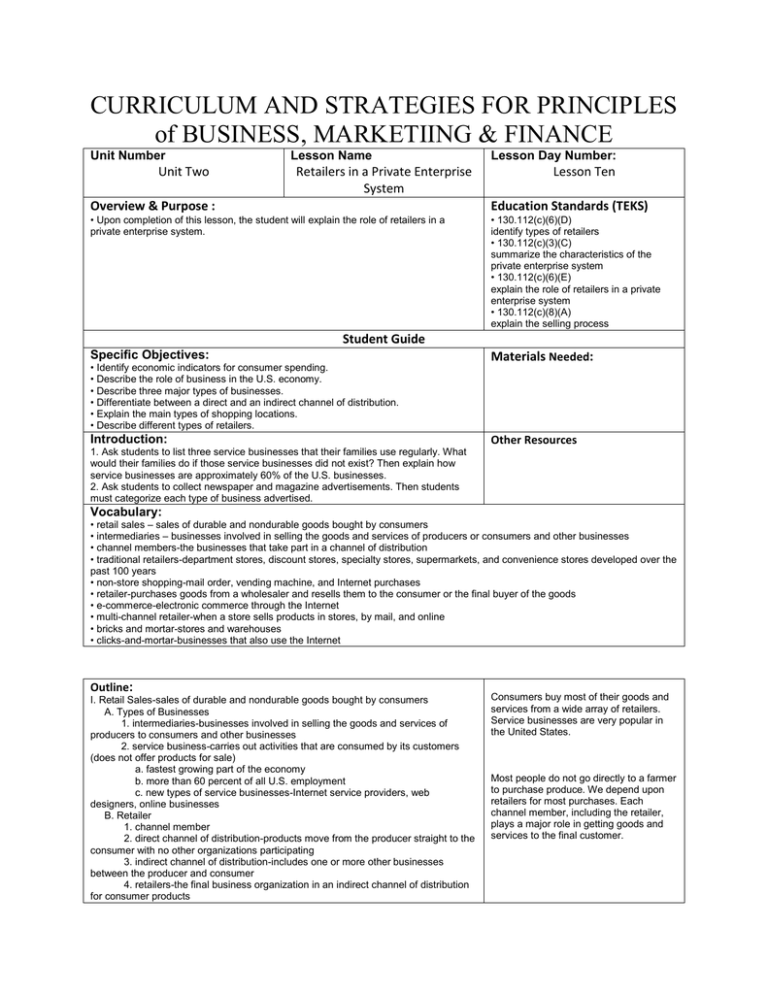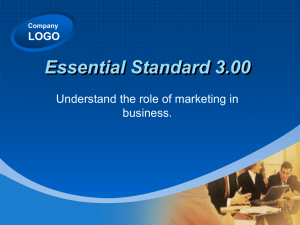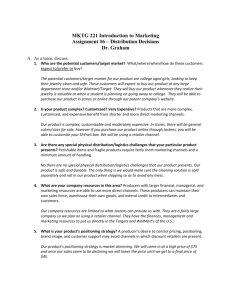Specific Objectives
advertisement

CURRICULUM AND STRATEGIES FOR PRINCIPLES of BUSINESS, MARKETIING & FINANCE Unit Number Unit Two Lesson Name Retailers in a Private Enterprise System Lesson Day Number: Lesson Ten Overview & Purpose : Education Standards (TEKS) • Upon completion of this lesson, the student will explain the role of retailers in a private enterprise system. • 130.112(c)(6)(D) identify types of retailers • 130.112(c)(3)(C) summarize the characteristics of the private enterprise system • 130.112(c)(6)(E) explain the role of retailers in a private enterprise system • 130.112(c)(8)(A) explain the selling process Student Guide Specific Objectives: • Identify economic indicators for consumer spending. • Describe the role of business in the U.S. economy. • Describe three major types of businesses. • Differentiate between a direct and an indirect channel of distribution. • Explain the main types of shopping locations. • Describe different types of retailers. Introduction: Materials Needed: Other Resources 1. Ask students to list three service businesses that their families use regularly. What would their families do if those service businesses did not exist? Then explain how service businesses are approximately 60% of the U.S. businesses. 2. Ask students to collect newspaper and magazine advertisements. Then students must categorize each type of business advertised. Vocabulary: • retail sales – sales of durable and nondurable goods bought by consumers • intermediaries – businesses involved in selling the goods and services of producers or consumers and other businesses • channel members-the businesses that take part in a channel of distribution • traditional retailers-department stores, discount stores, specialty stores, supermarkets, and convenience stores developed over the past 100 years • non-store shopping-mail order, vending machine, and Internet purchases • retailer-purchases goods from a wholesaler and resells them to the consumer or the final buyer of the goods • e-commerce-electronic commerce through the Internet • multi-channel retailer-when a store sells products in stores, by mail, and online • bricks and mortar-stores and warehouses • clicks-and-mortar-businesses that also use the Internet Outline: I. Retail Sales-sales of durable and nondurable goods bought by consumers A. Types of Businesses 1. intermediaries-businesses involved in selling the goods and services of producers to consumers and other businesses 2. service business-carries out activities that are consumed by its customers (does not offer products for sale) a. fastest growing part of the economy b. more than 60 percent of all U.S. employment c. new types of service businesses-Internet service providers, web designers, online businesses B. Retailer 1. channel member 2. direct channel of distribution-products move from the producer straight to the consumer with no other organizations participating 3. indirect channel of distribution-includes one or more other businesses between the producer and consumer 4. retailers-the final business organization in an indirect channel of distribution for consumer products Consumers buy most of their goods and services from a wide array of retailers. Service businesses are very popular in the United States. Most people do not go directly to a farmer to purchase produce. We depend upon retailers for most purchases. Each channel member, including the retailer, plays a major role in getting goods and services to the final customer. C. Traditional Retailers 1. department stores-Nordstroms, Macys 2. discount stores-Walmart 3. specialty stores (limited-line retailers)-Ace Hardware and Foot Locker 4. super markets-HEB 5. convenience stores-gas station with a mini mart D. Contemporary Retailers 1. specialty superstores-Home Depot, Office Depot 2. warehouse club-no-frills outlet 3. factory outlets or off-price stores-T.J. Maxx, Stein Mart 4. superstores and hypermarkets-Kroger 5. showroom retailers-display samples of their products and take orders from customers-Service Merchandise E. Non-store Shopping 1. mail order 2. vending machines 3. Internet Looking Forward: Q: What is an intermediary? A: The intermediary is a business involved in selling the goods and services of producers to consumers and other businesses. Q: Which type of business is the fastest growing in the United States? A: Service businesses are the fastest growing in the United States. Q: What is a direct channel of distribution? A: A direct channel of distribution occurs when products move from the producer straight to the consumer with no other organizations participating. Q: Why are prices higher at a convenience store? A: Prices are higher because the convenience store carries a limited quantity of merchandise. Q: Why have specialty superstore become popular? A: Consumers like to make one stop for all of their needs; the superstore provides this convenience. Q: What is a factory outlet store? A: A factory outlet store carries large quantities at lower prices. Clothing outlet stores carry end-of-the-season or last season’s styles at lower prices. Q: What type of retailer is a luxury automobile dealership? A: The luxury automobile dealership is a showroom retailer. Consumers choose a car that frequently has to be special ordered. SHOPPING MALL ASSIGNMENT Ask students to visit their favorite shopping mall and list ten stores that are located in the mall. Then students must categorize each type of retailer. Ask students to prepare a PowerPoint presentation that gives information about each of the ten retailers, explains the categorization of each retailer, and describe advertising used by each retailer. Traditional retailers can be found in shopping malls across America. Shopping malls have felt changes in consumers buying patterns influenced by Internet sales. Specialty superstores like the Home Depot have become increasingly popular because individuals like the idea of a onestop location for all home improvements, garden, appliances, and other home needs.








